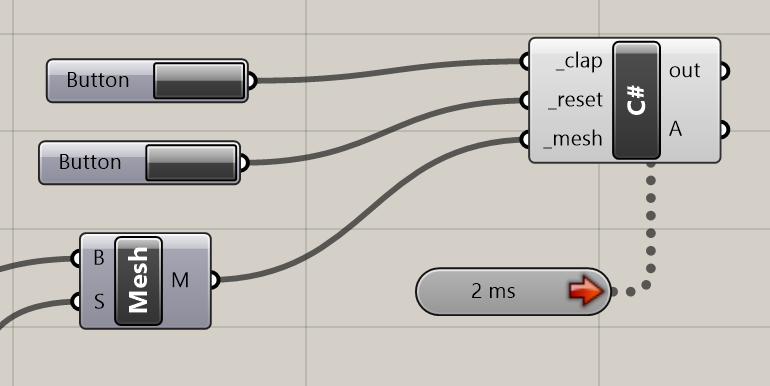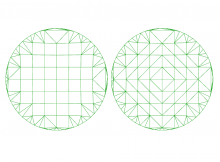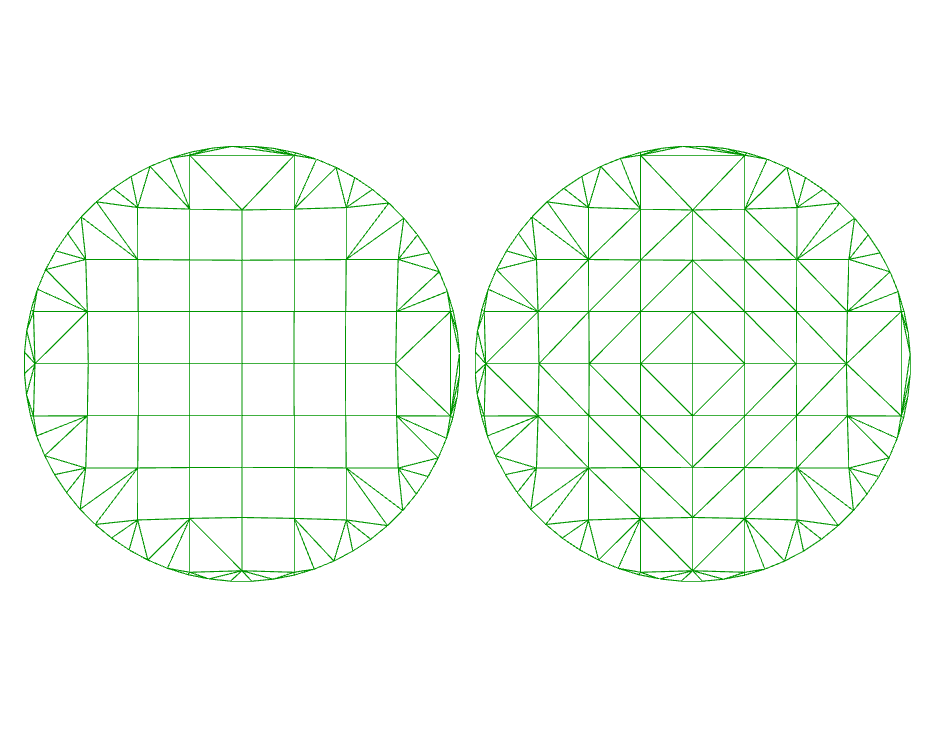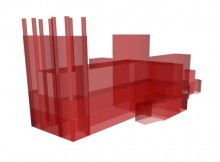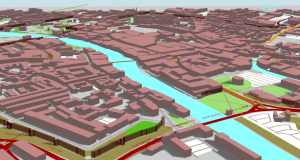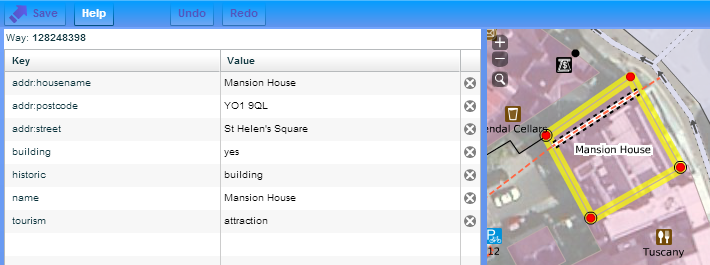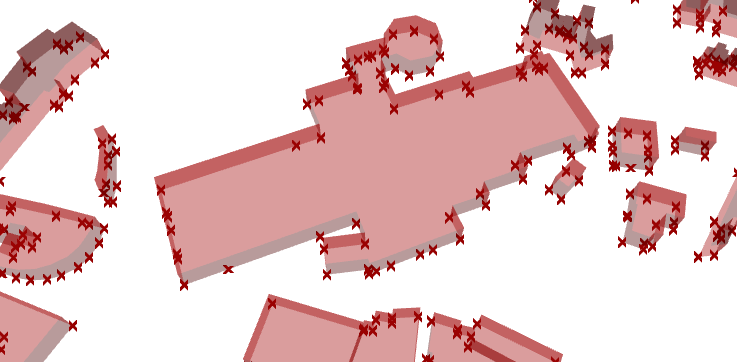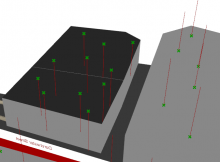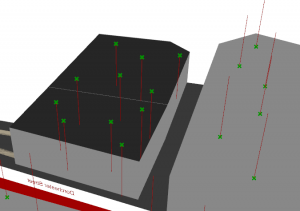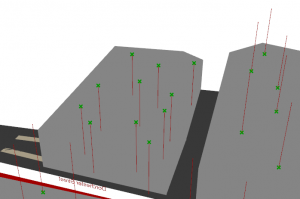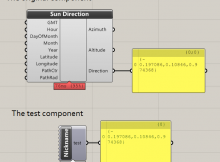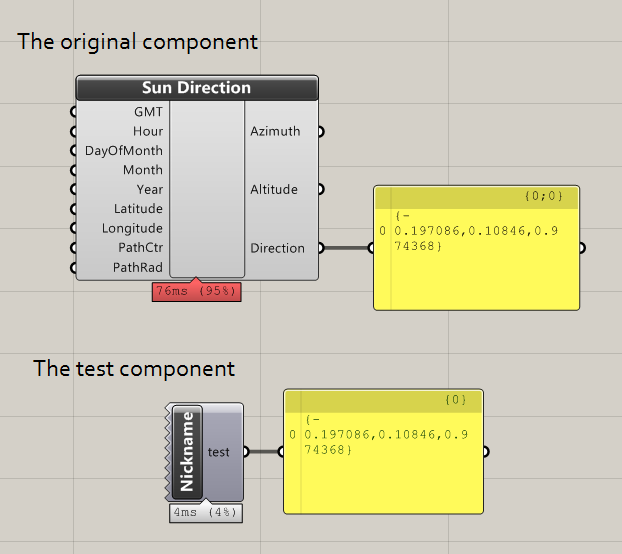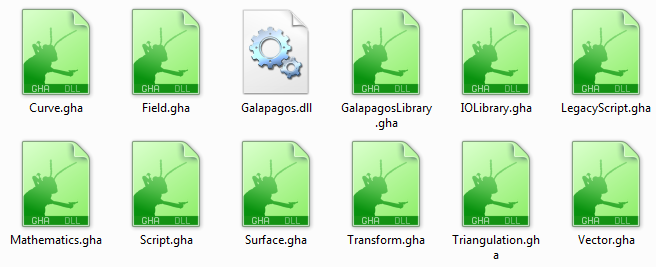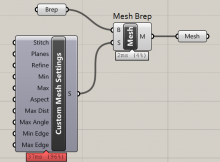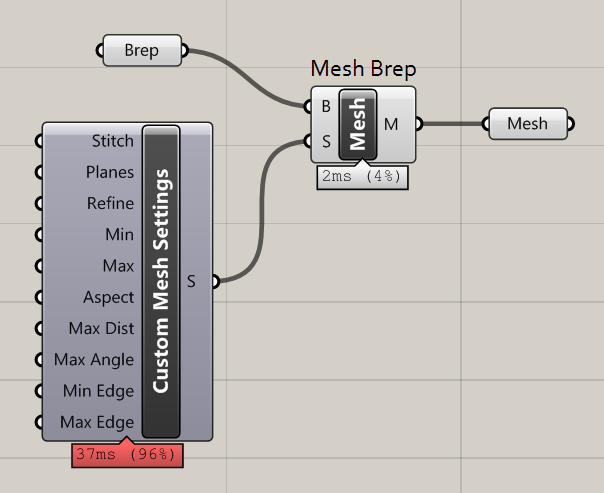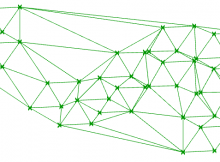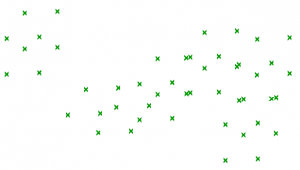The UTCI calculates an equivalent perceived temperature based upon air temperature, radiative temperature, humidity and air movement. You may be familiar with the UTCI from weather forecasts when they say something like “the air temperature is 30C but it is going to feel more like 35C”. The UTCI is suitable as a method for calculating outdoor thermal comfort levels.
The Equivalent Temperature outputted by UTCI calculations can then be aligned to levels of thermal comfort:
The interaction between these four values into a single Equivalent Temperature is complex. A function, created via the method of curve-fitting, has been created by Broede as Fortran here, which is a (long!) one-line approximation of UTCI calculation. Fortran isn’t perhaps the most useful language to the average developer today, so what I have done is translate it into C# and tidy it a little by splitting up some methods.
To use the code below, create a new class in your .NET project and copy the code below. Methods are saved as public static classes.
Once you have added the UTCI class in your project (below), you can calculate the UTCI by calling the following method:
The method returns a double corresponding to the UTCI in degrees C.
public static class C_UTCI
{
/*
!~ UTCI, Version a 0.002, October 2009
!~ Copyright (C) 2009 Peter Broede
!~ Program for calculating UTCI Temperature (UTCI)
!~ released for public use after termination of COST Action 730
!~ replaces Version a 0.001, from September 2009
* */
/// <summary>
/// Calculate UTCI
/// </summary>
/// <param name="Ta">Dry bulb air temp, degC</param>
/// <param name="va">Air movement, m/s</param>
/// <param name="Tmrt">Radiant temperature</param>
/// <param name="RH">Relative humidity, 0-100%</param>
/// <returns>UTCI 'perceived' temperature, degC. Returns double.min if input is out of range for model</returns>
public static double CalcUTCI(double Ta, double va, double Tmrt, double RH)
{
if (CheckIfInputsValid(Ta, va, Tmrt, RH) != InputsChecks.Pass) return double.MinValue;
double ehPa = es(Ta) * (RH / 100.0);
double D_Tmrt = Tmrt - Ta;
double Pa = ehPa / 10.0;// convert vapour pressure to kPa
#region whoa_mamma
double UTCI_approx = Ta +
(0.607562052) +
(-0.0227712343) * Ta +
(8.06470249 * Math.Pow(10, (-4))) * Ta * Ta +
(-1.54271372 * Math.Pow(10, (-4))) * Ta * Ta * Ta +
(-3.24651735 * Math.Pow(10, (-6))) * Ta * Ta * Ta * Ta +
(7.32602852 * Math.Pow(10, (-8))) * Ta * Ta * Ta * Ta * Ta +
(1.35959073 * Math.Pow(10, (-9))) * Ta * Ta * Ta * Ta * Ta * Ta +
(-2.25836520) * va +
(0.0880326035) * Ta * va +
(0.00216844454) * Ta * Ta * va +
(-1.53347087 * Math.Pow(10, (-5))) * Ta * Ta * Ta * va +
(-5.72983704 * Math.Pow(10, (-7))) * Ta * Ta * Ta * Ta * va +
(-2.55090145 * Math.Pow(10, (-9))) * Ta * Ta * Ta * Ta * Ta * va +
(-0.751269505) * va * va +
(-0.00408350271) * Ta * va * va +
(-5.21670675 * Math.Pow(10, (-5))) * Ta * Ta * va * va +
(1.94544667 * Math.Pow(10, (-6))) * Ta * Ta * Ta * va * va +
(1.14099531 * Math.Pow(10, (-8))) * Ta * Ta * Ta * Ta * va * va +
(0.158137256) * va * va * va +
(-6.57263143 * Math.Pow(10, (-5))) * Ta * va * va * va +
(2.22697524 * Math.Pow(10, (-7))) * Ta * Ta * va * va * va +
(-4.16117031 * Math.Pow(10, (-8))) * Ta * Ta * Ta * va * va * va +
(-0.0127762753) * va * va * va * va +
(9.66891875 * Math.Pow(10, (-6))) * Ta * va * va * va * va +
(2.52785852 * Math.Pow(10, (-9))) * Ta * Ta * va * va * va * va +
(4.56306672 * Math.Pow(10, (-4))) * va * va * va * va * va +
(-1.74202546 * Math.Pow(10, (-7))) * Ta * va * va * va * va * va +
(-5.91491269 * Math.Pow(10, (-6))) * va * va * va * va * va * va +
(0.398374029) * D_Tmrt +
(1.83945314 * Math.Pow(10, (-4))) * Ta * D_Tmrt +
(-1.73754510 * Math.Pow(10, (-4))) * Ta * Ta * D_Tmrt +
(-7.60781159 * Math.Pow(10, (-7))) * Ta * Ta * Ta * D_Tmrt +
(3.77830287 * Math.Pow(10, (-8))) * Ta * Ta * Ta * Ta * D_Tmrt +
(5.43079673 * Math.Pow(10, (-10))) * Ta * Ta * Ta * Ta * Ta * D_Tmrt +
(-0.0200518269) * va * D_Tmrt +
(8.92859837 * Math.Pow(10, (-4))) * Ta * va * D_Tmrt +
(3.45433048 * Math.Pow(10, (-6))) * Ta * Ta * va * D_Tmrt +
(-3.77925774 * Math.Pow(10, (-7))) * Ta * Ta * Ta * va * D_Tmrt +
(-1.69699377 * Math.Pow(10, (-9))) * Ta * Ta * Ta * Ta * va * D_Tmrt +
(1.69992415 * Math.Pow(10, (-4))) * va * va * D_Tmrt +
(-4.99204314 * Math.Pow(10, (-5))) * Ta * va * va * D_Tmrt +
(2.47417178 * Math.Pow(10, (-7))) * Ta * Ta * va * va * D_Tmrt +
(1.07596466 * Math.Pow(10, (-8))) * Ta * Ta * Ta * va * va * D_Tmrt +
(8.49242932 * Math.Pow(10, (-5))) * va * va * va * D_Tmrt +
(1.35191328 * Math.Pow(10, (-6))) * Ta * va * va * va * D_Tmrt +
(-6.21531254 * Math.Pow(10, (-9))) * Ta * Ta * va * va * va * D_Tmrt +
(-4.99410301 * Math.Pow(10, (-6))) * va * va * va * va * D_Tmrt +
(-1.89489258 * Math.Pow(10, (-8))) * Ta * va * va * va * va * D_Tmrt +
(8.15300114 * Math.Pow(10, (-8))) * va * va * va * va * va * D_Tmrt +
(7.55043090 * Math.Pow(10, (-4))) * D_Tmrt * D_Tmrt +
(-5.65095215 * Math.Pow(10, (-5))) * Ta * D_Tmrt * D_Tmrt +
(-4.52166564 * Math.Pow(10, (-7))) * Ta * Ta * D_Tmrt * D_Tmrt +
(2.46688878 * Math.Pow(10, (-8))) * Ta * Ta * Ta * D_Tmrt * D_Tmrt +
(2.42674348 * Math.Pow(10, (-10))) * Ta * Ta * Ta * Ta * D_Tmrt * D_Tmrt +
(1.54547250 * Math.Pow(10, (-4))) * va * D_Tmrt * D_Tmrt +
(5.24110970 * Math.Pow(10, (-6))) * Ta * va * D_Tmrt * D_Tmrt +
(-8.75874982 * Math.Pow(10, (-8))) * Ta * Ta * va * D_Tmrt * D_Tmrt +
(-1.50743064 * Math.Pow(10, (-9))) * Ta * Ta * Ta * va * D_Tmrt * D_Tmrt +
(-1.56236307 * Math.Pow(10, (-5))) * va * va * D_Tmrt * D_Tmrt +
(-1.33895614 * Math.Pow(10, (-7))) * Ta * va * va * D_Tmrt * D_Tmrt +
(2.49709824 * Math.Pow(10, (-9))) * Ta * Ta * va * va * D_Tmrt * D_Tmrt +
(6.51711721 * Math.Pow(10, (-7))) * va * va * va * D_Tmrt * D_Tmrt +
(1.94960053 * Math.Pow(10, (-9))) * Ta * va * va * va * D_Tmrt * D_Tmrt +
(-1.00361113 * Math.Pow(10, (-8))) * va * va * va * va * D_Tmrt * D_Tmrt +
(-1.21206673 * Math.Pow(10, (-5))) * D_Tmrt * D_Tmrt * D_Tmrt +
(-2.18203660 * Math.Pow(10, (-7))) * Ta * D_Tmrt * D_Tmrt * D_Tmrt +
(7.51269482 * Math.Pow(10, (-9))) * Ta * Ta * D_Tmrt * D_Tmrt * D_Tmrt +
(9.79063848 * Math.Pow(10, (-11))) * Ta * Ta * Ta * D_Tmrt * D_Tmrt * D_Tmrt +
(1.25006734 * Math.Pow(10, (-6))) * va * D_Tmrt * D_Tmrt * D_Tmrt +
(-1.81584736 * Math.Pow(10, (-9))) * Ta * va * D_Tmrt * D_Tmrt * D_Tmrt +
(-3.52197671 * Math.Pow(10, (-10))) * Ta * Ta * va * D_Tmrt * D_Tmrt * D_Tmrt +
(-3.36514630 * Math.Pow(10, (-8))) * va * va * D_Tmrt * D_Tmrt * D_Tmrt +
(1.35908359 * Math.Pow(10, (-10))) * Ta * va * va * D_Tmrt * D_Tmrt * D_Tmrt +
(4.17032620 * Math.Pow(10, (-10))) * va * va * va * D_Tmrt * D_Tmrt * D_Tmrt +
(-1.30369025 * Math.Pow(10, (-9))) * D_Tmrt * D_Tmrt * D_Tmrt * D_Tmrt +
(4.13908461 * Math.Pow(10, (-10))) * Ta * D_Tmrt * D_Tmrt * D_Tmrt * D_Tmrt +
(9.22652254 * Math.Pow(10, (-12))) * Ta * Ta * D_Tmrt * D_Tmrt * D_Tmrt * D_Tmrt +
(-5.08220384 * Math.Pow(10, (-9))) * va * D_Tmrt * D_Tmrt * D_Tmrt * D_Tmrt +
(-2.24730961 * Math.Pow(10, (-11))) * Ta * va * D_Tmrt * D_Tmrt * D_Tmrt * D_Tmrt +
(1.17139133 * Math.Pow(10, (-10))) * va * va * D_Tmrt * D_Tmrt * D_Tmrt * D_Tmrt +
(6.62154879 * Math.Pow(10, (-10))) * D_Tmrt * D_Tmrt * D_Tmrt * D_Tmrt * D_Tmrt +
(4.03863260 * Math.Pow(10, (-13))) * Ta * D_Tmrt * D_Tmrt * D_Tmrt * D_Tmrt * D_Tmrt +
(1.95087203 * Math.Pow(10, (-12))) * va * D_Tmrt * D_Tmrt * D_Tmrt * D_Tmrt * D_Tmrt +
(-4.73602469 * Math.Pow(10, (-12))) * D_Tmrt * D_Tmrt * D_Tmrt * D_Tmrt * D_Tmrt * D_Tmrt +
(5.12733497) * Pa +
(-0.312788561) * Ta * Pa +
(-0.0196701861) * Ta * Ta * Pa +
(9.99690870 * Math.Pow(10, (-4))) * Ta * Ta * Ta * Pa +
(9.51738512 * Math.Pow(10, (-6))) * Ta * Ta * Ta * Ta * Pa +
(-4.66426341 * Math.Pow(10, (-7))) * Ta * Ta * Ta * Ta * Ta * Pa +
(0.548050612) * va * Pa +
(-0.00330552823) * Ta * va * Pa +
(-0.00164119440) * Ta * Ta * va * Pa +
(-5.16670694 * Math.Pow(10, (-6))) * Ta * Ta * Ta * va * Pa +
(9.52692432 * Math.Pow(10, (-7))) * Ta * Ta * Ta * Ta * va * Pa +
(-0.0429223622) * va * va * Pa +
(0.00500845667) * Ta * va * va * Pa +
(1.00601257 * Math.Pow(10, (-6))) * Ta * Ta * va * va * Pa +
(-1.81748644 * Math.Pow(10, (-6))) * Ta * Ta * Ta * va * va * Pa +
(-1.25813502 * Math.Pow(10, (-3))) * va * va * va * Pa +
(-1.79330391 * Math.Pow(10, (-4))) * Ta * va * va * va * Pa +
(2.34994441 * Math.Pow(10, (-6))) * Ta * Ta * va * va * va * Pa +
(1.29735808 * Math.Pow(10, (-4))) * va * va * va * va * Pa +
(1.29064870 * Math.Pow(10, (-6))) * Ta * va * va * va * va * Pa +
(-2.28558686 * Math.Pow(10, (-6))) * va * va * va * va * va * Pa +
(-0.0369476348) * D_Tmrt * Pa +
(0.00162325322) * Ta * D_Tmrt * Pa +
(-3.14279680 * Math.Pow(10, (-5))) * Ta * Ta * D_Tmrt * Pa +
(2.59835559 * Math.Pow(10, (-6))) * Ta * Ta * Ta * D_Tmrt * Pa +
(-4.77136523 * Math.Pow(10, (-8))) * Ta * Ta * Ta * Ta * D_Tmrt * Pa +
(8.64203390 * Math.Pow(10, (-3))) * va * D_Tmrt * Pa +
(-6.87405181 * Math.Pow(10, (-4))) * Ta * va * D_Tmrt * Pa +
(-9.13863872 * Math.Pow(10, (-6))) * Ta * Ta * va * D_Tmrt * Pa +
(5.15916806 * Math.Pow(10, (-7))) * Ta * Ta * Ta * va * D_Tmrt * Pa +
(-3.59217476 * Math.Pow(10, (-5))) * va * va * D_Tmrt * Pa +
(3.28696511 * Math.Pow(10, (-5))) * Ta * va * va * D_Tmrt * Pa +
(-7.10542454 * Math.Pow(10, (-7))) * Ta * Ta * va * va * D_Tmrt * Pa +
(-1.24382300 * Math.Pow(10, (-5))) * va * va * va * D_Tmrt * Pa +
(-7.38584400 * Math.Pow(10, (-9))) * Ta * va * va * va * D_Tmrt * Pa +
(2.20609296 * Math.Pow(10, (-7))) * va * va * va * va * D_Tmrt * Pa +
(-7.32469180 * Math.Pow(10, (-4))) * D_Tmrt * D_Tmrt * Pa +
(-1.87381964 * Math.Pow(10, (-5))) * Ta * D_Tmrt * D_Tmrt * Pa +
(4.80925239 * Math.Pow(10, (-6))) * Ta * Ta * D_Tmrt * D_Tmrt * Pa +
(-8.75492040 * Math.Pow(10, (-8))) * Ta * Ta * Ta * D_Tmrt * D_Tmrt * Pa +
(2.77862930 * Math.Pow(10, (-5))) * va * D_Tmrt * D_Tmrt * Pa +
(-5.06004592 * Math.Pow(10, (-6))) * Ta * va * D_Tmrt * D_Tmrt * Pa +
(1.14325367 * Math.Pow(10, (-7))) * Ta * Ta * va * D_Tmrt * D_Tmrt * Pa +
(2.53016723 * Math.Pow(10, (-6))) * va * va * D_Tmrt * D_Tmrt * Pa +
(-1.72857035 * Math.Pow(10, (-8))) * Ta * va * va * D_Tmrt * D_Tmrt * Pa +
(-3.95079398 * Math.Pow(10, (-8))) * va * va * va * D_Tmrt * D_Tmrt * Pa +
(-3.59413173 * Math.Pow(10, (-7))) * D_Tmrt * D_Tmrt * D_Tmrt * Pa +
(7.04388046 * Math.Pow(10, (-7))) * Ta * D_Tmrt * D_Tmrt * D_Tmrt * Pa +
(-1.89309167 * Math.Pow(10, (-8))) * Ta * Ta * D_Tmrt * D_Tmrt * D_Tmrt * Pa +
(-4.79768731 * Math.Pow(10, (-7))) * va * D_Tmrt * D_Tmrt * D_Tmrt * Pa +
(7.96079978 * Math.Pow(10, (-9))) * Ta * va * D_Tmrt * D_Tmrt * D_Tmrt * Pa +
(1.62897058 * Math.Pow(10, (-9))) * va * va * D_Tmrt * D_Tmrt * D_Tmrt * Pa +
(3.94367674 * Math.Pow(10, (-8))) * D_Tmrt * D_Tmrt * D_Tmrt * D_Tmrt * Pa +
(-1.18566247 * Math.Pow(10, (-9))) * Ta * D_Tmrt * D_Tmrt * D_Tmrt * D_Tmrt * Pa +
(3.34678041 * Math.Pow(10, (-10))) * va * D_Tmrt * D_Tmrt * D_Tmrt * D_Tmrt * Pa +
(-1.15606447 * Math.Pow(10, (-10))) * D_Tmrt * D_Tmrt * D_Tmrt * D_Tmrt * D_Tmrt * Pa +
(-2.80626406) * Pa * Pa +
(0.548712484) * Ta * Pa * Pa +
(-0.00399428410) * Ta * Ta * Pa * Pa +
(-9.54009191 * Math.Pow(10, (-4))) * Ta * Ta * Ta * Pa * Pa +
(1.93090978 * Math.Pow(10, (-5))) * Ta * Ta * Ta * Ta * Pa * Pa +
(-0.308806365) * va * Pa * Pa +
(0.0116952364) * Ta * va * Pa * Pa +
(4.95271903 * Math.Pow(10, (-4))) * Ta * Ta * va * Pa * Pa +
(-1.90710882 * Math.Pow(10, (-5))) * Ta * Ta * Ta * va * Pa * Pa +
(0.00210787756) * va * va * Pa * Pa +
(-6.98445738 * Math.Pow(10, (-4))) * Ta * va * va * Pa * Pa +
(2.30109073 * Math.Pow(10, (-5))) * Ta * Ta * va * va * Pa * Pa +
(4.17856590 * Math.Pow(10, (-4))) * va * va * va * Pa * Pa +
(-1.27043871 * Math.Pow(10, (-5))) * Ta * va * va * va * Pa * Pa +
(-3.04620472 * Math.Pow(10, (-6))) * va * va * va * va * Pa * Pa +
(0.0514507424) * D_Tmrt * Pa * Pa +
(-0.00432510997) * Ta * D_Tmrt * Pa * Pa +
(8.99281156 * Math.Pow(10, (-5))) * Ta * Ta * D_Tmrt * Pa * Pa +
(-7.14663943 * Math.Pow(10, (-7))) * Ta * Ta * Ta * D_Tmrt * Pa * Pa +
(-2.66016305 * Math.Pow(10, (-4))) * va * D_Tmrt * Pa * Pa +
(2.63789586 * Math.Pow(10, (-4))) * Ta * va * D_Tmrt * Pa * Pa +
(-7.01199003 * Math.Pow(10, (-6))) * Ta * Ta * va * D_Tmrt * Pa * Pa +
(-1.06823306 * Math.Pow(10, (-4))) * va * va * D_Tmrt * Pa * Pa +
(3.61341136 * Math.Pow(10, (-6))) * Ta * va * va * D_Tmrt * Pa * Pa +
(2.29748967 * Math.Pow(10, (-7))) * va * va * va * D_Tmrt * Pa * Pa +
(3.04788893 * Math.Pow(10, (-4))) * D_Tmrt * D_Tmrt * Pa * Pa +
(-6.42070836 * Math.Pow(10, (-5))) * Ta * D_Tmrt * D_Tmrt * Pa * Pa +
(1.16257971 * Math.Pow(10, (-6))) * Ta * Ta * D_Tmrt * D_Tmrt * Pa * Pa +
(7.68023384 * Math.Pow(10, (-6))) * va * D_Tmrt * D_Tmrt * Pa * Pa +
(-5.47446896 * Math.Pow(10, (-7))) * Ta * va * D_Tmrt * D_Tmrt * Pa * Pa +
(-3.59937910 * Math.Pow(10, (-8))) * va * va * D_Tmrt * D_Tmrt * Pa * Pa +
(-4.36497725 * Math.Pow(10, (-6))) * D_Tmrt * D_Tmrt * D_Tmrt * Pa * Pa +
(1.68737969 * Math.Pow(10, (-7))) * Ta * D_Tmrt * D_Tmrt * D_Tmrt * Pa * Pa +
(2.67489271 * Math.Pow(10, (-8))) * va * D_Tmrt * D_Tmrt * D_Tmrt * Pa * Pa +
(3.23926897 * Math.Pow(10, (-9))) * D_Tmrt * D_Tmrt * D_Tmrt * D_Tmrt * Pa * Pa +
(-0.0353874123) * Pa * Pa * Pa +
(-0.221201190) * Ta * Pa * Pa * Pa +
(0.0155126038) * Ta * Ta * Pa * Pa * Pa +
(-2.63917279 * Math.Pow(10, (-4))) * Ta * Ta * Ta * Pa * Pa * Pa +
(0.0453433455) * va * Pa * Pa * Pa +
(-0.00432943862) * Ta * va * Pa * Pa * Pa +
(1.45389826 * Math.Pow(10, (-4))) * Ta * Ta * va * Pa * Pa * Pa +
(2.17508610 * Math.Pow(10, (-4))) * va * va * Pa * Pa * Pa +
(-6.66724702 * Math.Pow(10, (-5))) * Ta * va * va * Pa * Pa * Pa +
(3.33217140 * Math.Pow(10, (-5))) * va * va * va * Pa * Pa * Pa +
(-0.00226921615) * D_Tmrt * Pa * Pa * Pa +
(3.80261982 * Math.Pow(10, (-4))) * Ta * D_Tmrt * Pa * Pa * Pa +
(-5.45314314 * Math.Pow(10, (-9))) * Ta * Ta * D_Tmrt * Pa * Pa * Pa +
(-7.96355448 * Math.Pow(10, (-4))) * va * D_Tmrt * Pa * Pa * Pa +
(2.53458034 * Math.Pow(10, (-5))) * Ta * va * D_Tmrt * Pa * Pa * Pa +
(-6.31223658 * Math.Pow(10, (-6))) * va * va * D_Tmrt * Pa * Pa * Pa +
(3.02122035 * Math.Pow(10, (-4))) * D_Tmrt * D_Tmrt * Pa * Pa * Pa +
(-4.77403547 * Math.Pow(10, (-6))) * Ta * D_Tmrt * D_Tmrt * Pa * Pa * Pa +
(1.73825715 * Math.Pow(10, (-6))) * va * D_Tmrt * D_Tmrt * Pa * Pa * Pa +
(-4.09087898 * Math.Pow(10, (-7))) * D_Tmrt * D_Tmrt * D_Tmrt * Pa * Pa * Pa +
(0.614155345) * Pa * Pa * Pa * Pa +
(-0.0616755931) * Ta * Pa * Pa * Pa * Pa +
(0.00133374846) * Ta * Ta * Pa * Pa * Pa * Pa +
(0.00355375387) * va * Pa * Pa * Pa * Pa +
(-5.13027851 * Math.Pow(10, (-4))) * Ta * va * Pa * Pa * Pa * Pa +
(1.02449757 * Math.Pow(10, (-4))) * va * va * Pa * Pa * Pa * Pa +
(-0.00148526421) * D_Tmrt * Pa * Pa * Pa * Pa +
(-4.11469183 * Math.Pow(10, (-5))) * Ta * D_Tmrt * Pa * Pa * Pa * Pa +
(-6.80434415 * Math.Pow(10, (-6))) * va * D_Tmrt * Pa * Pa * Pa * Pa +
(-9.77675906 * Math.Pow(10, (-6))) * D_Tmrt * D_Tmrt * Pa * Pa * Pa * Pa +
(0.0882773108) * Pa * Pa * Pa * Pa * Pa +
(-0.00301859306) * Ta * Pa * Pa * Pa * Pa * Pa +
(0.00104452989) * va * Pa * Pa * Pa * Pa * Pa +
(2.47090539 * Math.Pow(10, (-4))) * D_Tmrt * Pa * Pa * Pa * Pa * Pa +
(0.00148348065) * Pa * Pa * Pa * Pa * Pa * Pa;
#endregion
return UTCI_approx;
}
/// <summary>
/// Calc saturation vapour pressure
/// </summary>
/// <param name="ta">Input air temperature, degC</param>
/// <returns></returns>
private static double es(double ta)
{
//calculates saturation vapour pressure over water in hPa for input air temperature (ta) in celsius according to:
//Hardy, R.; ITS-90 Formulations for Vapor Pressure, Frostpoint Temperature, Dewpoint Temperature and Enhancement Factors in the Range -100 to 100 °C;
//Proceedings of Third International Symposium on Humidity and Moisture; edited by National Physical Laboratory (NPL), London, 1998, pp. 214-221
//http://www.thunderscientific.com/tech_info/reflibrary/its90formulas.pdf (retrieved 2008-10-01)
double[] g = new double[] { -2836.5744, -6028.076559, 19.54263612, -0.02737830188, 0.000016261698, ((double)(7.0229056 * Math.Pow(10, -10))), ((double)(-1.8680009 * Math.Pow(10, -13))) };
double tk = ta + 273.15;
double es = 2.7150305 * Math.Log(tk);
//for count, i in enumerate(g):
for (int count = 0; count < g.Length; count++)
{
double i = g[count];
es = es + (i * Math.Pow(tk, (count - 2)));
}
es = Math.Exp(es) * 0.01;
return es;
}
public static InputsChecks CheckIfInputsValid(double Ta, double va, double Tmrt, double hum)
{
if (Ta < -50.0 || Ta > 50.0) return InputsChecks.Temp_OutOfRange;
if (Tmrt-Ta < -30.0 || Tmrt-Ta > 70.0) return InputsChecks.Large_Gap_Between_Trmt_Ta;
if (va < 0.5) return InputsChecks.WindSpeed_Too_Low;
if (va > 17) return InputsChecks.WindSpeed_TooHigh;
return InputsChecks.Pass;
}
public enum InputsChecks { Temp_OutOfRange, Large_Gap_Between_Trmt_Ta, WindSpeed_Too_Low, WindSpeed_TooHigh, Pass, Unknown }
}

